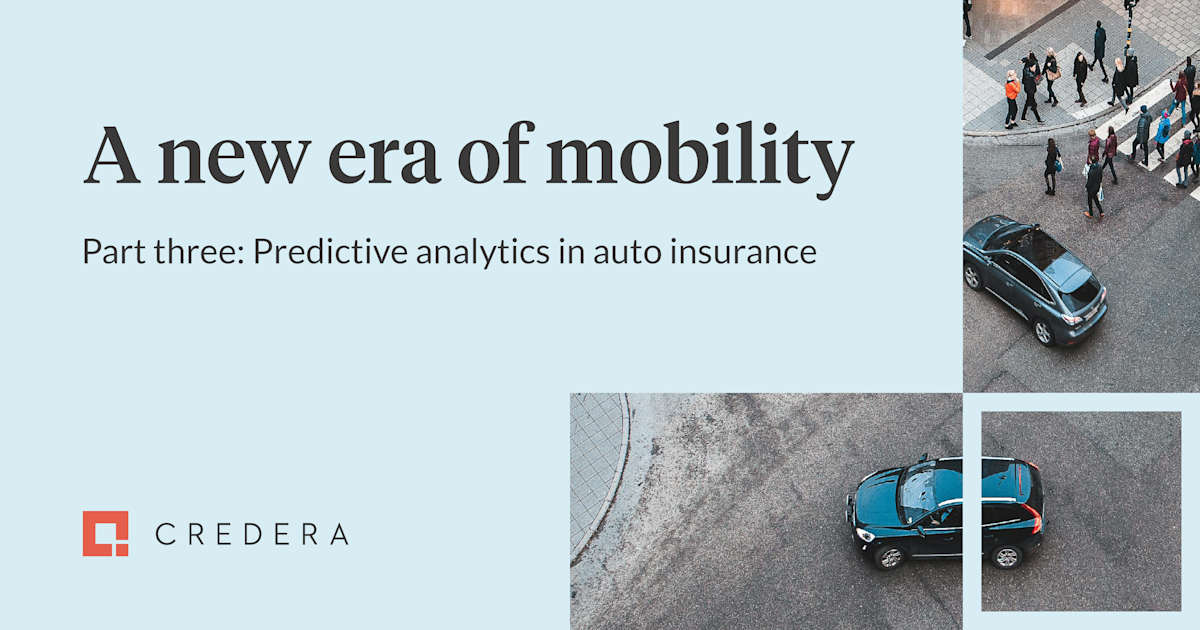Technology
Dec 02, 2024
A new era of mobility part three: Predictive analytics in auto insurance

The auto insurance industry is at a pivotal moment. With connected vehicles and the rise of big data, insurers and OEMs have the opportunity to redefine how they assess risk, handle claims, and engage with customers. Yet, while the tools and technology exist to improve safety and fairness, the current landscape remains fraught with challenges. Distrust between OEMs and insurers, driven by concerns over data monetisation and privacy, has stalled progress.
What’s needed is a shift in perspective - one where collaboration, transparency, and consent-driven data sharing lead to safer roads, fairer premiums, and less deaths on the road.
In the final installment of our three-part series, we delve into how predictive analytics is revolutionising the auto insurance industry and contributing to enhanced driver safety.
Leveraging telematics for risk anticipation
Traditionally, auto insurance has been built around risk assessment based on historical data - factors like a driver’s age, vehicle type, and accident history. However, with the rich data now accessible through connected cars, insurers can go beyond static factors and gain real-time insights into driving behaviour, environmental conditions, and vehicle health. Predictive analytics enables insurers to model potential risks dynamically, allowing for more accurate, personalised risk assessments.
For example, OEMs provide telematics data on real-time driving habits - such as speed, braking patterns, and miles driven - that insurers can use to assess risk more precisely. Through usage-based insurance (UBI) models, premiums can be tailored based on this real-time driving data, making insurance fairer for low-risk drivers and incentivising safer driving.
This approach doesn’t just provide fairer pricing but also helps insurers proactively identify high-risk scenarios. By analysing patterns in vehicle data, insurers can predict conditions that may lead to accidents or breakdowns and alert customers or provide preventive solutions in advance.
Privacy concerns and the need for consent and full transparency
The use of telematics data in vehicles presents significant privacy and ethical concerns. One major issue is the potential for unauthorised or excessive data collection, often without clear consent from drivers, with notable legal actions currently underway in the US.
Many drivers are unaware of the full scope of data being collected - such as location, speed, and behaviour - or how it may be used, leading to concerns about detailed profiling and misuse by third parties. Additionally, telematics systems are vulnerable to cyberattacks and breaches, raising questions about the security of sensitive personal information.
Legal and ethical issues also arise around data ownership, cross-jurisdictional sharing, and function creep - where data initially collected for safety purposes might later be used for unrelated or intrusive applications, such as surveillance or compliance monitoring. In commercial settings, employees may feel their autonomy is compromised by constant tracking, while insurance models based on telematics could unintentionally discriminate against certain demographics. Furthermore, the knowledge of being monitored could limit individuals’ freedom of movement and behaviour, creating a chilling effect.
To balance these concerns with the safety benefits of telematics, robust safeguards are necessary. Clear and transparent consent processes, data anonymisation, strict retention limits, and strong security measures should be enforced. Regulatory oversight and ethical standards must ensure that telematics data is used responsibly, preserving individual rights while leveraging the technology for safer roads.
Significant benefits for drivers and society
Streamlining claims processing with predictive analytics: Predictive analytics can and is revolutionising the traditionally slow claims process by automating and optimising workflows. By leveraging data from connected vehicles, accident reports, and environmental factors, insurers can expedite claims verification, damage assessment, and settlements. This real-time data-driven approach reduces wait times for customers while also identifying fraudulent claims through pattern analysis, enhancing efficiency and safeguarding honest policyholders and reducing their premiums.
Enhancing customer experience through personalisation: Predictive analytics also enables insurers to offer personalised services tailored to individual customer needs. Insights from connected vehicles help insurers design customised policies, provide driving behaviour insights, and offer proactive services like maintenance reminders and vehicle issue alerts. This personalisation improves customer loyalty by delivering value beyond traditional coverage, enriching the overall insurance experience.
Financial penalties discourage poor and dangerous driving habits: Every year, thousands of road deaths are caused by poor and careless driving, with factors like speeding, harsh braking, and distracted driving contributing significantly to accidents, delays, and deaths. The use of telematics will address this by monitoring driving behaviour and linking insurance premiums to performance. Drivers with risky or dangerous driver habits will face higher costs and potential exclusion, thus driving higher standards and safer practices.
Making it happen and the need for collaboration between OEMs and Insurers
The benefits of predictive analytics in auto insurance are most pronounced when OEMs and insurers collaborate. OEMs, as data gatekeepers of connected vehicles, can supply insurers with the vast data streams necessary for predictive analytics. This collaboration creates opportunities for new insurance products that cater to the connected car era, such as dynamic premiums that adjust with real-time driving behaviour, and increased revenue streams for both parties.
As this collaboration grows, it’s likely we’ll see the emergence of innovative insurance products that go beyond traditional models, such as policies tailored to autonomous vehicles or advanced driver assistance systems (ADAS). These products may provide additional layers of security and peace of mind for consumers while ensuring that insurance offerings evolve alongside automotive technology.
A shift toward proactive risk management
Perhaps the most transformative impact of predictive analytics is the shift it enables from reactive to proactive risk management. Instead of waiting for an accident or incident to trigger a response, insurers can proactively engage with policyholders to prevent risks before they occur. This approach aligns well with the growing focus on vehicle safety and driver wellbeing in the automotive industry.
By identifying high-risk situations in advance, insurers can reach out to customers with tailored advice or preventive maintenance suggestions. This proactive stance not only benefits drivers but also reduces the frequency and severity of claims, which can have a positive impact on insurance pricing across the board.
Building a safer, fairer future
Predictive analytics offers a unique opportunity to align the interests of drivers, insurers, and OEMs. By using real-time data to anticipate risks, reduce premiums, and encourage safer driving, the industry can deliver tangible benefits to society. This is the world we should strive for - one where technology and data don’t just serve profits but protect lives.
How Credera can help
At Credera, we specialise in providing cutting-edge data technology solutions for the automotive and insurance industries. Our expertise in predictive analytics and data security enables OEMs and insurers to leverage big data effectively while ensuring compliance with privacy regulations. From data architecture to predictive model development, we’re here to help our clients transform their data into actionable insights, driving innovation and customer satisfaction across the automotive industry.
Contact Us
Let's talk!
We're ready to help turn your biggest challenges into your biggest advantages.
Searching for a new career?
View job openings


